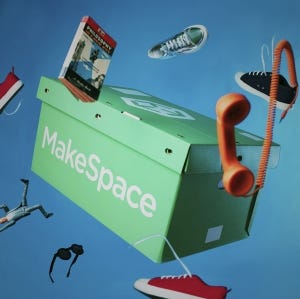Competition or Inspiration: Are Valet-Storage Businesses Disrupting the Traditional Self-Storage Market or Providing Impetus for Change?
Valet-storage businesses began springing up with frequency in 2013 and continue to gain traction with consumers and investors. The big questions for self-storage operators are: How much competition do these valet operators truly present; and how much disruption are they likely to cause in the traditional self-storage market?

A couple of years ago, just as self-storage development began to rouse from its recession-induced hibernation, a competing business model predicated on pickup/delivery and bin-storage services also began to stir. Referred to as valet, personalized or “full-service” storage, this white-glove approach primarily targets urban dwellers who require small amounts of space and see value in paying by the box vs. renting a storage unit.
Although valet storage isn’t a new concept, startups began springing up in major metropolitan markets with frequency in 2013 and continue to gain traction with consumers and investors who see big potential in mobilizing, customizing and personalizing the storage business. These companies leverage technology—namely the Web and mobile apps—to streamline operation and appeal to convenience-hungry customers.
Several companies have launched stateside in recent months including Boxbee Inc. in San Francisco, Closetbox in Denver, Clutter in Los Angeles, Fetch Storage in Boston, MakeSpace Labs Inc. in New York City, Remote Garage in San Antonio and Storrage Inc. in Seattle. There are about a dozen or more in operation, and many are scaling quickly. Boxbee wasted no time in adding New York City as a service area. Closetbox is now operating in six states, while MakeSpace and Storrage have designs to expand nationally.
There’s also a growing roster of international players. By late last summer, there were a handful of valet operators in the London market. One of those is SpaceWays, a company launched in the United Kingdom by Germany-based parent company Rocket Internet AG, a venture-capital firm specializing in e-commerce and business startups. Rocket Internet quickly mobilized the SpaceWays brand, expanding service last year to Chicago, Paris and Toronto, and adding Sydney to its list in 2015.
The thing that’s likely caught the attention of traditional self-storage developers is the valet model’s speed to market. While a self-storage project may take years and millions of dollars to build, valet businesses have shortened that window to months and traded real estate investment for a technological infrastructure. The big questions for self-storage operators are: How much competition do these valet operators truly present; and how much disruption are they likely to cause in the traditional self-storage market?
A Closer Look
 There are important distinctions in how valet operators conduct business. The key service points are door-to-door pickup and delivery of belongings, a digital catalog of stored items, and tools to manage stored inventory, typically through a mobile app or Web dashboard. Contents are stored in a secure warehouse, which customers aren’t allowed to access.
There are important distinctions in how valet operators conduct business. The key service points are door-to-door pickup and delivery of belongings, a digital catalog of stored items, and tools to manage stored inventory, typically through a mobile app or Web dashboard. Contents are stored in a secure warehouse, which customers aren’t allowed to access.
Pricing is typically by the bin ($4 to $8 per month), or users can pay a flat monthly fee that includes a certain number of bins. Storage of large or bulky items generally runs between $10 and $20 per item, per month. Initial pickup of bins going into storage is usually free, and delivery of items ranges from $7 to $30, depending on the operator and setup of services.
In some cases, customers can rent warehouse space by square footage. At Closetbox, rent starts at $12 per month and $2 per box for bin storage, and ranges from about $70 per month for 25 square feet of space to around $300 per month for 200 square feet, according to the company website. The equivalent of a 10-by-10-foot space ranges from $151 to $186 per month, depending on the city.
 “While we compete in the traditional self-storage market, the main differentiators include convenience, organization and bite-sized pricing,” says Kristoph Matthews, CEO of Boxbee. The valet business model is tailor-made for residents in dense urban populations where home storage is minimal, transportation is costly and the size of most self-storage units is unnecessary.
“While we compete in the traditional self-storage market, the main differentiators include convenience, organization and bite-sized pricing,” says Kristoph Matthews, CEO of Boxbee. The valet business model is tailor-made for residents in dense urban populations where home storage is minimal, transportation is costly and the size of most self-storage units is unnecessary.
“The valet-storage model can work wherever there is under-utilized warehouse space and available vehicles [for delivery service], but the focus will certainly be on the larger markets the first several years,” notes Brian Thomas, CEO of Clutter.
In some ways, valet-storage operators are fighting traditional self-storage businesses for the business of young urbanites in thick metro centers. According to the U.S. Census Bureau, the nation’s urban population increased 12.1 percent between the 2000 and 2010, which outpaced the overall U.S. growth rate of 9.7 percent. Urban areas now account for 80.7 percent of the U.S. population. Although rural population grew modestly in the decade between censuses, it continued to decline as a percentage of national population distribution.
While the density of downtown areas in cities like Chicago, Los Angeles and New York are natural fits for the valet model, operators are finding success in other markets within the top 50 U.S. metropolitan statistical areas.
“We actively seek out markets with high density, high cost per living, high-salaried areas with young demographics. The top 50 cities are a natural fit for the U.S. [market],” says Matthews. “While we think that urbanites are our early adopters, we're betting on the emergence of a new behavior of storage that will complement traditional storage and find its way into other geographic markets as well.”
Investor Interest
The scalable aspects of the valet model and its ability to change the way consumers think about storage has attracted significant investment from the technology space. MakeSpace has raised more than $10 million in funding, while Boxbee has surpassed $7.3 million. Storrage has announced plans to raise $7 million is Series A funding this year.
 “Venture capitalists are interested in investing in companies that leverage technology as a competitive advantage, particularly in large markets,” says Sam Rosen, founder and CEO of MakeSpace. “In our case, it was the logistics piece that intersected with the traditional real estate business.”
“Venture capitalists are interested in investing in companies that leverage technology as a competitive advantage, particularly in large markets,” says Sam Rosen, founder and CEO of MakeSpace. “In our case, it was the logistics piece that intersected with the traditional real estate business.”
The variety of investors involved in the early stages of the valet-storage wave is impressive. Storrage investors include individuals connected to Amazon, Costco, Facebook and Microsoft. MakeSpace investors include Founders Fund, OATV (O'Reilly AlphaTech Ventures) and UpFront Ventures. (If those names are unfamiliar, Founders Fund is connected to Facebook, Spotify and others, while OATV has interests in Foursquare.)
Boxbee also has drawn significant interest from tech investors, including Google Ventures, Internet entrepreneur Jason Calacanis and investment firm Floodgate Fund LP. Interest at Floodgate has been led by co-founding partner Ann Miura-Ko, who has also invested in SpareFoot, an online self-storage marketplace that helps consumers find and reserve traditional self-storage units.
 “Storage is an incredibly attractive market with incredible stickiness with consumers,” notes Miura-Ko. “As technology investors, we believe that the use of platforms can force multiply the capabilities of the storage market. Much the same way companies like Lyft and Uber have fundamentally transformed the transportation market, we believe that companies like Boxbee and SpareFoot will transform the relationship between customers and the things they own.”
“Storage is an incredibly attractive market with incredible stickiness with consumers,” notes Miura-Ko. “As technology investors, we believe that the use of platforms can force multiply the capabilities of the storage market. Much the same way companies like Lyft and Uber have fundamentally transformed the transportation market, we believe that companies like Boxbee and SpareFoot will transform the relationship between customers and the things they own.”
The enticement for investors may be in discovering the storage version of Uber, which quickly became the standard for app-based car services. The trick is in identifying a candidate with large-scale promise and return on investment, something Miura-Ko calls a “Thunderlizard.”
“We respond to what we call Thunderlizards, which are inspired by Godzilla,” she explains. “There are only 10 to 15 businesses that exit at $1 billion-plus, and we have to believe that there is a potential to build such a business when we invest.”
Disrupting the Market
For a valet-storage business to become a Thunderlizard would likely mean sizable disruption in the marketplace. While valet operators don’t necessarily believe their model is a full-on replacement for traditional storage services, they do view self-storage as an antiquated business slow to adapt to a changing consumer landscape. As a result, they’re confident the scalability of their logistics and technology model has the capacity to alter at least the small-storage segment of the marketplace and consumer behavior.
“The self-storage market is ripe for disruption because it’s a huge market with sticky customers and frustrating existing options,” asserts Thomas. “Investors understand the opportunity to use technology to pair customers with too much stuff with under-utilized warehouse space. The technology that allows full-service storage companies like Clutter to deliver a superior service at prices competitive to self-storage is particularly attractive and why you’re seeing technology investors instead of real estate investors placing big bets in the space.”
This is why the case of Winchester, Va.-based self-storage operator Storage Solutions is so intriguing. In December 2013, Storage Solutions launched a Web-application service called Itimizit that enables customers to rent only the space they need, manage stored belongings online, and request valet pickup and delivery service for individual items. Noah White, CEO of Storage Solutions parent company White Properties Inc., says he came up with the idea in part because he believed the technology used to track customers’ boxes and files in records storage was cumbersome and expensive. Unaware of developments in valet-style storage at that time, White began conceiving a service that could apply to records storage as well as personal belongings.
“What if we could store those items on racks in a climate-controlled warehouse and take advantage of our ceiling height?” he recalls. “If we could do this, we could get a better return on our square footage and fill up our excess warehouse space.”
White says he didn’t learn about the valet-storage movement until two months before the Itimizit launch, but when he read an article about the concept, “it brought validity to the idea and a potential emerging market.” As a result, Storage Solutions and Itimizit are run collaboratively through a consultative approach to best match services to customer needs. “We know many storage customers do not fill the entire unit and could be a good candidate for item storage,” he says.
White believes the timing was probably right for the industry to grapple with valet-style services. “There will always be a market for traditional self-storage because there will always be a customer who wants [his] own space and access. But as more valet-storage business emerges, we could begin to see the emergence of a new customer,” he explains. “Current operators should remain aware how valet-storage operations are evolving and differentiating themselves from traditional operations. The rise of valet storage is inevitable in a world where consumers want options and are willing to pay for them.”
Driving Adjustments
As more providers emerge or expand into new markets, valet operators believe their presence will eventually force self-storage operators to adjust operations in some capacity. “Recently, we have seen the traditional self-storage industry make small accommodations in response to innovation in the space and changing consumer expectations,” notes Rosen. “We maintain that there will always be a need for traditional self-storage, but we hope to change the way people think and approach their storage needs.”
Adjustments from the traditional sector may come in the form of rethinking the self-storage customer experience, according to Clutter’s Thomas. “For example, I expect more storage operators will provide free mobile apps to help customers create their own photo catalog of the items in storage. A handful of these already exist, such as CubeSmart’s SmartTrakr; but there are ample opportunities to make this type of app a point of differentiation and a valuable tool for potential and existing customers,” he explains.
 Boxbee’s Matthews expects more self-storage operators to incorporate on-demand services and technology solutions similar to the valet space as well as build on a facility’s mix of onsite amenities and mix-use services. “While we continue to innovate and expand into other markets, traditional self-storage retailers with more high-quality services and multi-use premises will rise above the rest in a largely commoditized industry that competes on price,” he asserts.
Boxbee’s Matthews expects more self-storage operators to incorporate on-demand services and technology solutions similar to the valet space as well as build on a facility’s mix of onsite amenities and mix-use services. “While we continue to innovate and expand into other markets, traditional self-storage retailers with more high-quality services and multi-use premises will rise above the rest in a largely commoditized industry that competes on price,” he asserts.
Others are less sure valet storage will have much direct impact on the greater self-storage market. Phil Murphy, who owns and operates 14 self-storage facilities in Illinois under the Next Door Storage brand, believes the impact will be limited primarily to the segment of tenants who rent the smallest storage units. “I don't believe this will have much effect on the storage industry outside of very small renters. Valet-storage providers aren't battling self-storage; instead they are battling inertia,” asserts Murphy. “They have to convince customers that it is better to store with them rather than keeping [items] in their closet or under their bed.”
Murphy has a unique perspective on this wave of valet-storage businesses. He launched Storage By The Box, a by-the-bin storage model, in 2010, drawing praise as a young entrepreneur and drawing the attention of investors interested in duplicating the concept in London and elsewhere in Europe. From 2011 to 2013, Murphy served on the board of directors for valet-storage operator LoveSpace, which raised more than £1.5 million in 2014 through the online crowdfunding platform Crowdcube.
Murphy also believes the by-the-bin aspects to valet storage limit its appeal to traditional self-storage consumers, except those with little home storage or bulky items they don’t have room for inside their homes. “As soon as the amount of storage gets beyond this point, the financial benefits of by-the-box storage evaporates,” he says. “Instead, it becomes a premium service that, at the most, will affect renters of 5-by-5 units or below. When I operated Storage By The Box, our average amount of storage was eight boxes.”
The Future of Valet Storage
While the number of valet-storage businesses to emerge in such a short period has been noteworthy, Murphy says the activity is aided by low barriers to entry and somewhat reminiscent of the market activity four years ago. “This same thing happened when I launched Storage By The Box,” he notes. “After we started getting considerable press, we saw about eight or nine copycats spring up. Within a few years, all of them were out of business, and even though we were the last man standing, it wasn't enough to sustain the business.”
The current slate of valet operators are banking that the technology aspects of their business will have staying power as customers become accustomed to the evolving service slate. Clutter, which is a bit unusual in the market in that it has built a sizable portion of its business on individual, bulky items, has already  noticed that customers quickly gravitate to the cataloging aspect of the service, even if it wasn’t part of their initial purchase decision.
noticed that customers quickly gravitate to the cataloging aspect of the service, even if it wasn’t part of their initial purchase decision.
“We’ve found that the ability to see pictures of stored items is something customers love once they have it, but I don’t think it’s a driving consideration at the point of purchase,” Thomas says. “If you ask customers before they sign up how much they care about being able to see photos of their items, they see it as somewhat interesting but not as a must-have. But once they see how easily they can manage their extra stuff from their computer or phone, they love the photo cataloging.”
The traction could come from more robust services that build off the catalog concept. Vaultd, another valet startup, last year launched a peer-to-peer storage networking service for University of Michigan students. Around the same time, Boxbee began test marketing a library service in which customers can lend or sell items to others.
“What we’re really building is an information and logistics network. Rather than a ‘service,’ it will look like a platform that people can plug into to manage, store, organize, transport, or otherwise manipulate their stuff,” explains Matthews. “A further example of this technology platform: Our business customers can tap into  our logistics network through our API [application programming interface] and design their own logistics storage network on top of our infrastructure. While these are some of our patented technologies at the moment, we see endless possibilities here and are excited to see what other innovators in the industry come up with.”
our logistics network through our API [application programming interface] and design their own logistics storage network on top of our infrastructure. While these are some of our patented technologies at the moment, we see endless possibilities here and are excited to see what other innovators in the industry come up with.”
Rosen also believes the “mobility of things” aspect to the business will increase the emphasis on individual items rather than the collective stuff stored in a bin, whether sharing with others or having a set of golf clubs delivered to a favorite course for tee time. “Itemization is where the industry is headed,” he says. “Being able to catalog—via both photographs and description—every little thing a user is storing can open up other innovations and opportunities.”
The push toward innovation is a positive one for White of Storage Solutions, who believes valet’s influence on the mobilization of storage will be a natural extension of self-storage. “As current operators expand and valet storage evolves, [self-storage] operators may want to assess the market potential for adding valet services to their operations,” he says. “In today’s world, people want options, and valet storage provides options and a turnkey solution to store your stuff. If current operators stand flatfooted and do not perform due diligence on valet storage, they may lose out on a huge opportunity to capture a new customer base and grow their business.”
About the Author(s)
You May Also Like







